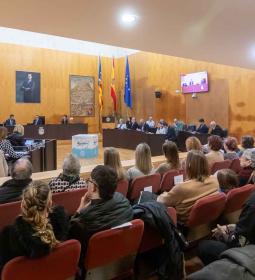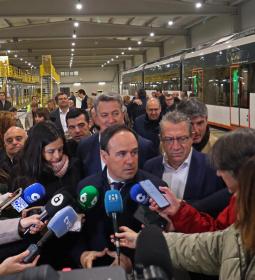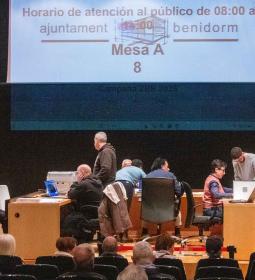At Brussels Le Plaza Auditorium, Toni Pérez explains the measures adopted to make a city friendlier to people, more enviorenment-friendly and with fewer accidents
'Benidorm, Friendly City 10, 20, 30' invited to the event before the European Mobility Week

In a session that Torsten Klimke, general director of Mobility and Transport of the European Union, has closed, the mayor of Benidorm has participated, transferring the example, selected for the annual workshop before the European Mobility Week, of the application in Benidorm of the proposal Benidorm, friendly city; Awareness 10, 20, 30.
As an example of good practices, in the 'Inspiration and Connection' panel, Toni Pérez has presented Benidorm's proposal, together with the other five selected from Europe: Bologna (Italy), Katowice (Poland), Konya (Turkey), Nova Gorica (Slovenia) and the proposal Metropolis GZM that make up 41 municipalities altogether, belonging to the Silesia region (Poland).
The mayor of Benidorm has highlighted the proposal for "a friendlier city to live in and come on vacation", pointing out that it is part of a compact city where there are no long distances among points of interest. Pérez has insisted that Benidorm action "focuses on increasing the efficiency and importance of sustainable means of transport by raising awareness among all vehicle drivers."
Pérez has insisted on the suitability and effectiveness of the measure as "a clear commitment to road safety and the commitment to sustainable mobility". The concept of a 'friendly city' entails achieving vehicular traffic within the framework of 20 km/h speed, "a measure implemented in most urban roads, allowing circulation up to speed limits of 30 km/h on the main access roads ”.
In the session, held at Le Plaza Auditorium in Brussels, organized by Eucities, ICLEI and Polis, with the support of the European Union, the mayor of Benidorm highlighted "the role in raising awareness that information radars have played, showing drivers the real speed at which they travel" and that has resulted in "reducing at least 10 km/h on each of the roads where they were installed". In the case of Avenida Juan Pablo II, this reduction has been 15 km/h.
Pérez has outlined the chapter on streets with no sidewalks in various streets and the example of vehicular traffic on Avenida del Mediterráneo, "where you must circulate at 10 km/h giving priority to pedestrians, as it is one of the main roads of the city, parallel to Levante Beach”.
Toni Pérez has closed his speech by explaining to the audience that "in Benidorm, 70% of journeys are on foot and with these measures implemented, the city of Benidorm, a tourist destination per excellence, is much friendlier to pedestrians and the environment. The accident rate has been reduced thanks to the new speed limits”, after pointing out Benidorm's commitment to the use of bicycles and personal mobility vehicles.
Improving the coexistence of residents and tourists with traffic is one of the operational premises of the Benidorm City Council Government team.
Measures taken
Since the drafting of the Benidorm Sustainable Urban Mobility Plan, in a clear commitment to road safety and the promotion of sustainable mobility, the generic speed of 20 km/h has been implemented in Benidorm on most of the roads in the municipality, On the main access roads to the city, with two lanes in each direction, speeds have been limited to 30 km/h, while in particularly sensitive areas, such as those close to school entrances, areas sports, pedestrian zones with authorized passage allowed, etc., the speed has been limited to 10 km/h.
Other plans have followed this: Sustainable Urban Transport Plan (2017), Global Road Safety Plan (2018), Sustainable Parking Plan, Universal Accessibility Plan (2018) and Benidorm Cycling Plan (2020).
To make drivers aware and make their speed more visible, a large number of speed bumps have been built and 9 sets of educational radars and a conventional radar cabin have been installed at strategic points on the main roads, which are intended to continue to be gradually expanded.
In the pedagogical radars the speed at which one circulates is indicated; in green when it is equal to or less than the maximum allowed and in red when it is exceeded. The numerical indication is accompanied by an icon of a face that: is smiling and green if the speed is respected or sad and red otherwise. As a complement to the educational radars, conventional radars were installed, which, despite not having detection systems and therefore being unable to issue sanctions, have been found to fulfil their main mission of reducing speed.
The city's mobility transformation policy has been constant for several years and is firmly established, developed and there is a firm commitment to continue it, resulting in several projects that are now in the drafting and execution phase.
The set of action policies entails a discouragement of private vehicle circulation, promoting and encouraging the circulation of pedestrians, bicycles and personal mobility vehicles (the latter by bike lane and expressly authorized areas).
As an outstanding example, Avenida del Mediterráneo, which until not long ago seemed like a fast track within the city, has managed to reduce the average speed dramatically with all these measures, leaving it at 13 km/h.
The speed limit is also projected in an inclusive manner with a gender perspective. The pedestrian pictograms are egalitarian, emphasizing the pedestrian presence in pedestrian lanes from a gender perspective.
Reports from municipal technical services; the collaboration of associations; contributions from the Neighborhood Council, the Urban Scene Council and the Council for Sustainable Mobility, Universal Accessibility and Sustainable Energies, are all Councils involved in the need to improve universal accessibility and sustainable mobility.




